That is an intersting question as this is far from being obvious. Actually, for quite some time it was believed that planets should indeed spin retrograde (we can at least track it back to Laplace in his Exposition du Système du Monde published in 1976 where he developed his nebular hypothesis).
How to prove that planet should spin prograde? We'll have to go back to their formation history. Let's start with an ideal case: particles moving in eliptical orbits around a central object of mass $M$, with a proto-planet of mass $m_0$, and rotating in a eliptical orbit. Let's look at what happens at a given point at a distance $r$ from the central object. First, for a planetesimal in a tangential external orbit, then for a planetesimal in a tangential internal orbit.
Tangential external orbit
We can write Newton's Second Law ${\bf F} = m {\bf a}$ and project it on the current trajectory axis (normal and tangent), knowing that the acceleration is always something like $v^2/R$, with $R$ the curvature radius (that is different from $r$, the distance to the central object). We get for the normal component:
$$\frac{GM}{r^2} \cos \alpha = \frac{v_{ext}^2}{R_{ext}^2},$$
$R_{ext}$ being the curvature radius of the planetesimal in an external orbit. For the proto-planet:
$$\frac{GM}{r^2} \cos \alpha = \frac{v^2}{R^2},$$
$\alpha$ having the same value for both object, since it denotes the angle between the direction toward the curvature center and the central object and the orbits being tangential at this specific point, where $r$ the distance to the central object is also the same. Therefore:
$$\frac{v^2}{R^2} = \frac{v_{ext}^2}{R_{ext}^2}.$$
As $R < R_{ext}$, we have $v < v_{ext}$.
Tangetial internal orbit
With the same argument, we can show that $v > v_{int}$ (I let it as an exercice; extra bonus point if you do it with the energy conservation law).
Consequences
If you go in the reference frame of the protoplanet, you will see the internal planetesimal, rotating at a lower speed, coming backward, towards the proto-planet, and the external planetesimal, rotating at a faster speed, coming forward:

where $v'_{ext}$ and $v'_{int}$ are the velocity of the external and internal planetesimal in the reference fram of the proto-planet. That is why the rotation of the proto-planet tends to be in the same direction as the whole system.



